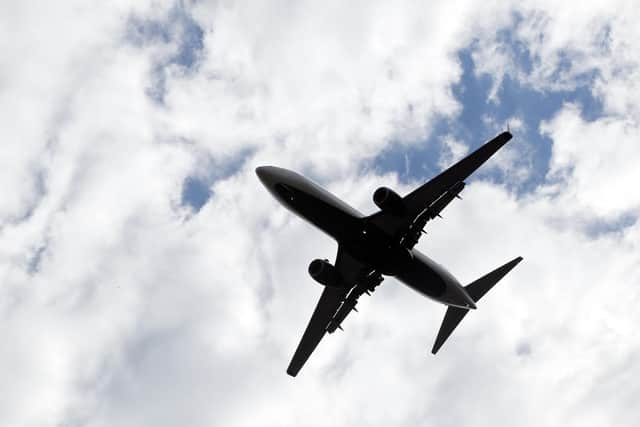Exclusive:Anger as over 300 'ghost flights' pass through Scottish airports in first quarter of 2023
More than three hundred so-called “ghost flights”, including dozens of international departures and arrivals, passed through Scotland’s airports in the first quarter of this year, intensifying concerns over the environmental impact of flights that are either empty or nearly empty.
Some 309 ghost passenger flights were recorded in the first three months of the year, according to official load factor data published by the Civil Aviation Authority (CAA), with over one in seven of those services - some 41 in all - taking to the air without any passengers or cargo on board. The completely empty flights include a scheduled departure from Inverness Airport to Amsterdam Airport Schiphol in the Netherlands, a journey of around 500 miles.
Advertisement
Hide AdAdvertisement
Hide AdThe frequency of the ghost flights is up nearly 25 per cent compared to the same period before the coronavirus pandemic brought about international travel restrictions that caused widespread disruption to the aviation sector.
The details of the continuing use of ghost flights, a practice described as “environmentally damaging” by the UK government, comes after The Scotsman revealed last month how more than 1,500 empty or nearly empty passenger flights departed or landed at Scottish airports last year.
There were among nearly 11,000 ghost flights to pass through the nation’s airports over the past four years, leading to widespread criticism by environmental groups and criticism of both governments at Edinburgh and Westminster for their failure to take action to curb aviation emissions.
The latest tranche of load factor data compiled by the CAA shows that 54 of the ghost flights that took place between January and March this year were to or from international destinations. They included multiple departures from Edinburgh Airport to the Canary Islands, a trip of around 2,000 miles, and a transatlantic flight between Glasgow and Canada.
Anna Hughes, director of Flight Free UK, a campaign group that urges the importance of reducing carbon emissions in order to avoid climate breakdown, said the operation of ghost flights amounted to a “shocking waste of resources” and a “needless source of emissions.”


“It's especially galling that planes continue to fly empty when many people are consciously flying less in an effort to reduce their carbon footprint,” she told The Scotsman. “If there is low demand for a route from, say, Edinburgh to the Canary Islands, why are those flights being scheduled, with all the emissions that involves?
“At a time when we should be doing all we can to reduce the amount of CO2 in our atmosphere, it should be incumbent on the government and the airlines to bring this practice to an end. Ghost flights are entirely unnecessary and waste our steadily dwindling carbon budget.”
Aberdeen Airport recorded the highest number of nearly empty flights, with 100. The majority of those - 11 departures and 63 arrivals - were oil rig flights, but the total included international flights between the city and Denmark, the Netherlands, Switzerland, and Norway.
Advertisement
Hide AdAdvertisement
Hide AdNext highest was Glasgow Airport, with 41 nearly empty flights. As well as Canada, other international destinations where flights either set off for or arrived from included Cyprus, Poland, and Spain. There were a total of 37 ghost flights at Sumburgh Airport in Shetland, five of which were completely empty.
Elsewhere, 20 nearly empty flights passed through Edinburgh Airport over the three month timeframe, including departures to the Canary Islands and Norway, as well as inbound flights from Croatia, Greece, Spain, and Turkey.
According to the latest CAA data, the airport with the highest number of empty flights was Kirkwall in Orkney. There were five departures and six arrivals at the airport with no passengers or cargo. All were flights between Orkney and other UK airports. Every one of the 15 main airports in Scotland saw ghost flights, with nine - Barra, Benbecula, Campbeltown, Inverness, Islay, Kirkwall, Stornoway, Sumburgh, and Tiree - recording completely empty flights.
Aviation sources have told The Scotsman there are a series of factors to explain the number of ghost flights over Scottish airspace, They include the impact of routes between Scotland and those airports with 'use-it-or-lose-it' slot restrictions, such as Heathrow, as well as training, repositioning, and maintenance flights.
The number of flights recorded is sharply down compared to the same quarter in 2022, when there were 100 empty and 487 nearly empty flights, although it is difficult to attribute trends, given international Covid-19 travel restrictions were still impacting air travel up until March last year. The Q1 total for 2023 is up on the same period in 2019, which predated the pandemic restrictions. Back then, there were only 42 empty and 206 nearly empty flights.
Tim Johnson, director of the Aviation Environment Federation, said: “Regardless of whether the industry can point to positioning or maintenance flights as an excuse, the frequency of ghost flights has gone up since 2019, despite growing prublic scrutiny of their associated emissions and the fact that traffic levels haven't fully recovered. This suggests that the industry has little or no interest in tackling this wasteful practice.”
Airlines UK, the trade body for UK registered airlines, said: “Typically each year there are around 500,000 aircraft movements to and from Scottish airports carrying nearly 30m terminal passengers, with only a tiny fraction operating without or with few passengers and for a variety of operational reasons.
“UK airlines are fully committed to achieving net zero emissions by 2050, whilst getting our customers where they want to go to visit family, friends and do business. Alongside filling our flights as much as possible, we are working to make ‘jet zero’ reality by supporting the modernisation of our airspace to further reduce carbon emissions, using at least 10% sustainable aviation fuel by 2030 and driving the development of zero emission commercial aircraft.”
Comments
Want to join the conversation? Please or to comment on this article.